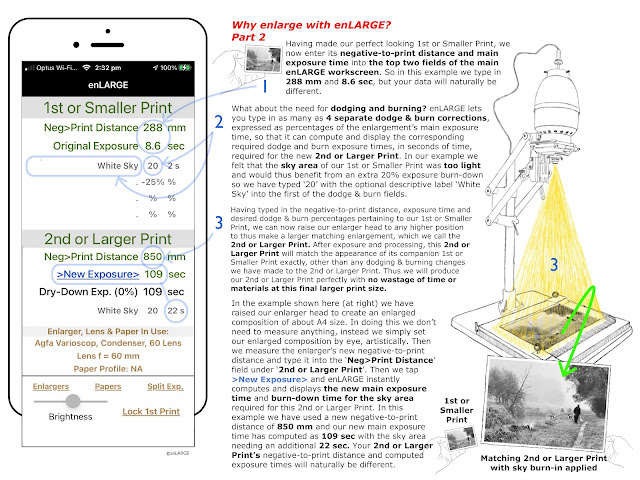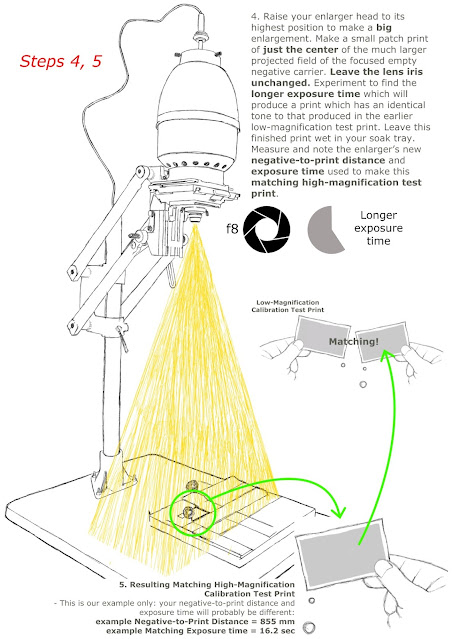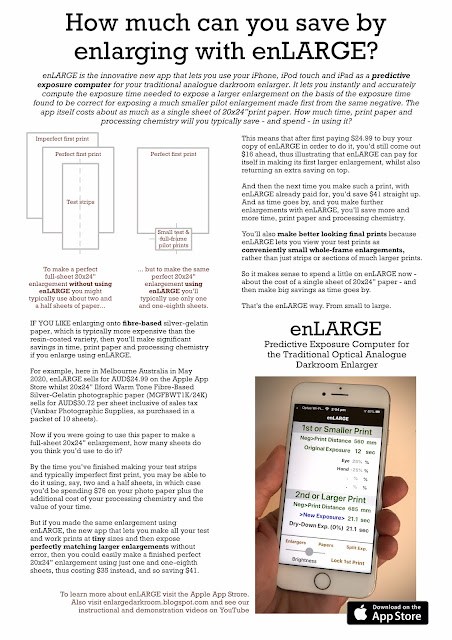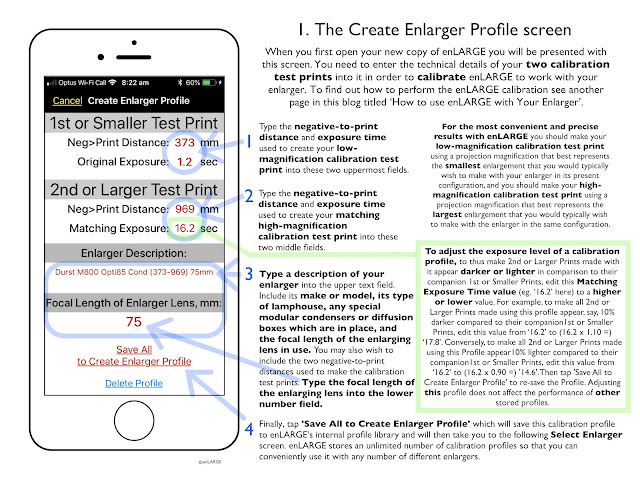Welcome to the official homepage of enLARGE, the iOS app that lets you use your iPhone, iPod touch and iPad as a Predictive Exposure Computer with your traditional analog darkroom optical enlarger
Total Pageviews
Facts, figures and specifications of enLARGE
- WHAT IS enLARGE? enLARGE is a revolutionary new app designed for use with your iPhone, iPod touch and iPad and your traditional optical darkroom enlarger. It lets you conveniently compute the exposure time needed to expose a larger enlargement once you know the exposure time needed to expose a smaller trial enlargement made first from the same negative. Thus using enLARGE you can test small — as small as 1X magnification, thus the trial enlargement can be as small as its source negative or larger — and then print matching enlargements of any larger size or sizes without making preliminary tests or erroneous prints at the larger sizes. This saves time, photo paper and processing chemistry. It also helps you make better looking enlargements by letting you work on your preliminary tests as small whole frame images rather than larger sectional test strips. Similarly enLARGE lets you easily make broad sets of differently sized perfectly matching enlargements from the one negative instead of enlarging to just one size only. In providing this functionality enLARGE also tracks and computes your enlargement’s dodge & burn times, compensates for your print paper’s dry-down, and manages split exposures, in which the larger enlargement’s exposure time is given using a series of shorter exposures.
- ENLARGER COMPATIBILITY: enLARGE works with both vertical and horizontal enlargers having negative formats of all sizes, eg. from negative formats of 8x11mm to 11x14” and beyond, and with enlarging lenses of all focal lengths, eg.15mm to 680mm and beyond, including wide-angle enlarging lenses, and with enlargers having condenser, diffusion, cold-light grid, dichroic, multigrade and LED panel lamphouses.
- CONTRAST & FILTRATION CONTROL COMPATIBILITY: enLARGE is compatible with all kinds of contrast and filtration control, including in-drawer filter gels, below-lens filters, dichroic and multigrade heads. It is compatible with neutral density filtration and enlarging lamp dimmers. It is compatible with split-grade and split-exposure enlarging. However, do not use enLARGE with polarising filters or variable neutral density filters which incorporate polarising filters placed in the projection path, as these will give erroneous results, as polarising filters transmit differing amounts of light under the differing optical geometries which are found in an enlarger at different enlargement sizes.
- ENLARGEMENT MAGNIFICATION RANGE: enLARGE works at all magnifications above 1X, thus when the projected image is the same size as its source negative or larger. enLARGE does not compute enlargement reductions, thus below 1X. enLARGE does not incorporate or use any preset print sizes, formats or shapes, instead you can use enLARGE at any and all enlargement magnifications above 1X, with no upper limit.
- OPERATING METHOD: When using enLARGE you never need to measure the size of your film negative or projected image, or compute the magnification of your projected image. Instead you simply measure the enlarger’s negative-to-print distance, thus the straight-line distance between the negative in the enlarger and the print paper at the print easel, using a metric tape measure, or for greater distances or with horizontal enlargers, a laser measure, and enLARGE makes its computations using this value.
- EXPOSURE TIME DISPLAY & DATA ENTRY: enLARGE displays its computed forecast exposure times to one decimal place (eg. 2.3 sec, 87.9 sec) for exposures up to 100 seconds, and then in whole seconds over 100 seconds (eg. 110 sec, 347 sec), with no upper exposure time limit. It displays associated dodge & burn exposure times, thus required for each current enlargement, in whole seconds, rounded up to the nearest whole second. Negative-to-Print distances, as measured at the enlarger by the user, must be entered into the enLARGE work screen as either whole millimeters or as millimeters to one or more decimal places.
- REQUIRED CALIBRATION WITH ENLARGER: Prior to use, enLARGE requires calibration to at least one enlarger in order to work accurately with it. During the calibration process, which you perform in the darkroom using your enlarger, your wet processing line and a few small scraps of photographic print paper, enLARGE records the relative difference in the brightness of your enlarger at two different enlargement magnifications, representing the smallest and largest enlargements you would typically wish to make with the enlarger in its particular configuration of lamphouse, negative format and enlarging lens. It stores this data as an enlarger calibration profile which it then uses to perform accurate predictive exposure computations for the making of enlargements of all sizes with the equipment. enLARGE stores an unlimited number of enlarger calibration profiles so that you can conveniently use it with any number of different enlargers or enlarger assemblies.
- iPhone, iPod touch and iPad COMPATIBILITY: enLARGE runs on all iPhone, iPod touch and iPad devices using iOS 9 and higher. It is not available on any other computing platform. In order to see all input and output data on all screens of enLARGE, your iPhone, iPod touch or iPad must be set to operate in Light mode, not Dark mode. Go to your device’s Settings menu and select Display & Brightness and select Light. Due to the way enLARGE is typically used in the enlarging process, there is typically no need to use it in a ‘lights-out’ darkroom condition in which the lit up screen of a device could accidentally spoil light-sensitive materials. Instead you will typically use enLARGE under white light conditions when planning your enlargement and then later when assessing test and final prints at the wet tray or drying station.
- ACCURACY: Provided that enLARGE is accurately calibrated to the enlarger in use, according to the instructions explained in this blog, it has no error. Thus variously sized enlargements made using enLARGE, from any one negative, can be made to match each other identically in their tonality, contrast and overall 'look' and appearance, the only visible difference between them being their relative sizes. enLARGE can also be programmed to compute exposure times according to any desired bias, thus, for example, that all enlarged prints dry to look eg. +10% darker than their smaller trial enlargements, or 5% lighter, etc.
- PURCHASE PRICE & UPGRADES: The purchase price, payable when purchasing enLARGE on the Apple App Store, supplies the full app for permanent use. There is nothing else to pay, purchase or add. enLARGE does not carry any advertising or promotional content, and it does not ask you to make any further purchases. All future upgrades are provided free of charge, simply download them from the Apple App Store as they become available.
- DEVELOPMENT: enLARGE has been developed by Andrew G. Wittner, Dip. Art & Design, Photography, PCAE, Melbourne Australia, a Master Darkroom Printer and enlarger operator with over 45 years of darkroom enlarging experience, and Soan K. S. Saini, a university trained professional programmer and specialist in Apple iOS coding, both of Melbourne, Australia. It was launched on the Apple App Store in June 2017 and has users worldwide in over 20 countries.
- CONTACT & SUPPORT: Contact Andrew G. Wittner directly using email andrew.wittner.photography@gmail.com. On Facebook Messenger contact Andrew Wittner.
Additional Features & Techniques with enLARGE; Troubleshooting enLARGE

- Using enLARGE with SPLIT-GRADE PRINTING
- Using enLARGE to record printing data
- Batch Processing with enLARGE
- Operating enLARGE in reverse mode
- Using enLARGE in a communal darkroom where several users share several different enlargers
- Troubleshooting enLARGE: What to do when 1st or Smaller Prints and 2nd or Larger Prints don’t match
Using enLARGE with SPLIT-GRADE PRINTING
Split-Grade printing lets you control the contrast of a black & white enlargement by exposing it through a sequence of two or more different contrast filters. For example, instead of simply exposing a black & white silver-gelatin enlargement for, say, 10 seconds using a medium-contrast Grade 2.5 filter, you could achieve a similar, or perhaps a slightly different result, by exposing it for, say, 4 seconds with a low-contrast Grade 0 filter, followed by 6 seconds with a high-contrast Grade 5 filter. Split-grade printing thus allows a more variable degree of contrast control, and it also allows you to expose different parts of the image using different contrast filters.
To use enLARGE with split-grade printing, begin in the usual way by producing a small perfect split-grade 1st or Smaller Print without using enLARGE at all. This will typically result in a split-grade 1st or Smaller Print which has two exposure times, eg. one of 4 seconds and one of 6 seconds, thus a separate exposure time for each of, say, two controlling filters. Now to use enLARGE to make a matching larger 2nd or Larger Print, you will perform the enLARGE computation for it twice: once using eg. 4 seconds in the 1st or Smaller Print's Original Exposure field and then by repeating the computation using eg. 6 seconds in it instead, to thus generate two new 2nd or Larger Print >New Exposure> times, thus one for use with each of the two controlling filters when exposing the larger enlargement.
A video on YouTube titled ‘Printing a Difficult Negative with enLARGE’, by Andrew G. Wittner, demonstrates the production of a split-grade enlargement using enLARGE.
Using enLARGE to record printing data
By saving a snapshot of the main enLARGE work screen to your device’s camera roll, you can record details of your enlarging work. In the example shown below, a series of two screenshots of the entire main enLARGE work screen has been saved to the iPhone’s camera roll, and then a third snapshot of the corresponding enlargement itself, whilst in the fixer or wash tray, has been recorded also to further assist picture identification and to record its appearance. Note also that one of the main enLARGE work screen’s dodge & burn label fields has been used instead to record a title or description for the relevant image. Recording such data to your camera roll can be useful if you wish to print the image again at a later date, as it gives you basic setup info including print sizing, main exposure time, dodge & burn data, choice of enlarger, lens and paper stock, which can thus help you to later replicate or work on the print.
Note that when producing a set of several differently sized enlargements from the one negative using enLARGE, that you may be able to batch process a complete set of enlargements in the one go. This means that you will process all of the prints together in your consecutive trays as a single batch of prints instead of processing just one print at a time. This can save processing time and will typically also ensure the most perfect visual uniformity across all of the prints in the set.
Operating enLARGE in reverse mode
enLARGE is designed to compute from small to large. This means that you will get the most perfect predictive computational accuracy from it when the 1st or Smaller Print is actually the smallest enlargement in any particular set, and all other 2nd or Larger Prints are actually larger than it. If you use enLARGE in reverse mode, which means that the 1st or Smaller Print is bigger than the 2nd or Larger Print, (for example, if you are predictively computing the exposure time needed for a smaller enlargement after first successfully printing a larger enlargement without using enLARGE) then you will find the result to be generally quite satisfactory, but possibly not quite as perfectly accurate as when enLARGE is used from small to large as originally intended by its processing algorithms. Thus for best results with enLARGE, remember to make the 1st or Smaller Print the smallest in the set.
Once an enlarger has been calibrated for use with enLARGE then its calibration data, as typed into enLARGE’s Create Enlarger Profile screen, can be shared amongst other darkroom workers who also hold a copy of enLARGE on their iPhone, iPod touch or iPad, so that they too can use the equipment with their copy of enLARGE without having to perform the enLARGE calibration process first.
Troubleshooting enLARGE: What to do when 1st or Smaller Prints and 2nd or Larger Prints don’t match
The essential function of enLARGE is to compute and supply accurate matching exposure times for enlargements of various sizes, based on the calibration that you prepare for it. Specifically, the 2nd or Larger pictorial Print should identically match the 1st or Smaller pictorial Print when both prints have had identical processing and are similarly wet at the water holding tray, and also after both prints have dried. If you find that a 2nd or Larger Print doesn't match the appearance of its companion 1st or Smaller Print, then consider these issues:
- Are you using the correct enlarger calibration profile for the equipment in use, or are you mistakenly using a calibration profile that belongs to a different enlarger setup? Check to make sure you are using the correct matching enLARGE calibration for the equipment in use including the use of any supplemental diffusion boxes and/or condenser lenses, and that the correct enlarging lens is in place.
- If you add an Anti-Newton Glass to the underside of the condenser in a Leitz Focomat l enlarger then this may affect the performance of the calibration because it causes the condenser lens to sit higher up in the lamphouse. If this causes a noticeable error in the matching exposure of a 2nd or Larger Print, you can correct it by editing the Matching Exposure value in the enlarger’s Create Enlarger Profile screen to a slightly higher or lower value as required. Alternatively a new calibration profile can be created and stored for use with the Anti-Newton Glass in place.
- If you recently changed the enlarging lamp, did you replace it with a lamp of the same physical size and did you replace it in the same physical position? If you replaced the lamp with one of a different size and/or you reinserted it in a different position, then this can affect the performance of the calibration. Thus after changing a lamp it’s a good idea to run a quick exposure-and-development test using two small pieces of print paper with the enlarger set at two different enlargement heights, to thus ensure that the calibration is still producing correctly forecast exposure times. If the larger-magnification patch test print appears darker than the lower-magnification test print then the Matching Exposure value in the enlarger’s Create Enlarger Profile screen needs to be edited to a lower value, whilst if the larger-magnification patch test print appears lighter than the lower-magnification test print then the Matching Exposure value in the Create Enlarger Profile screen needs to be edited to a higher value. Then resave the calibration profile and retest the computation in the main enLARGE work screen to ensure that enLARGE computes an exposure time which gives a correctly matching 2nd or Larger Print.
- Are you using in the light path a variable neutral density filter which thus incorporates a polarising filter? If so, this will give an erroneous result in the 2nd or Larger Print, as polarising filters pass differing amounts of light in the differing projection geometries found at different print magnifications. Thus variable neutral density filters which incorporate polarising filters, and polarising filters themselves, must not be used when using enLARGE.
- Are you using the same stock of print paper to make all of the different prints in your set? Different batches of print paper may have different emulsion speeds and/or tonal characteristics which will affect resulting print tonality.
- Is your paper developer exhausted? If you produce a larger 2nd or Larger Print and it appears dramatically too light compared to its smaller companion 1st or Smaller Print, then it may indicate that your paper developer is exhausted. It had enough energy to fully process the smaller 1st or Smaller Print, but not enough to process the larger 2nd or Larger Print. In this event you need to replace or replenish your developer and then restart your testing and printing process again.
- Whilst exposing the 1st or Smaller Print, are you using an excessively short exposure time, and/or did your enlarger lamp suffer a mains power dropout or fluctuation? The use of a very short exposure time when exposing the 1st or Smaller Print, eg. a fraction of second, and/or the occurrence of a mains power fluctuation during a very short exposure, may prevent the enlarger lamp from achieving full brightness for a sufficiently long time (the lamp’s ‘rise time’) and this will have the final effect of producing a 2nd or Larger Print which appears too dark in comparison to its 1st or Smaller Print. Thus it's good practice to use exposure times of at least a few seconds for your 1st or Smaller Print.
- When comparing a companion smaller 1st or Smaller Print and larger 2nd or Larger Print made from a film negative, you should be wary of what we call the ‘open grain’ effect, which is the tendency for flat, plain tones in larger enlargements to appear very fractionally lighter than their appearance in their smaller companion 1st or Smaller Print when the two prints are compared side by side. This occurs because in the larger 2nd or Larger Print the image's more greatly enlarged grain structure is easier to see and it introduces a patterned lightness into a flat tone which is not visible in the smaller print. (It is this effect which leads to the erroneous belief that the contrast of an enlargement changes with its magnification, whereas in fact it does not, as enLARGE will demonstrate to you in use. You will find when using enLARGE that print contrast remains identical at all enlargement magnifications provided that tonal density is kept identical, which enLARGE will achieve for you provided that its calibration has been accurately set.) Thus if the larger 2nd or Larger print is placed further away from the viewer so that it appears visually to be the same size as the smaller print, the latter which is thus held closer to the viewer, then the two tones will appear identical again. For this reason we recommend that you compare other, more complex tones also when judging the accuracy of printed results with enLARGE, and we also recommend, for the same reason, that calibrations and adjustments be made without using a film negative in the negative carrier.
- Note that changing the negative carrier in its size or format, or to one of glassed or glassless construction, will not affect the calibration.
- Changing the enlarger’s contrast filtration does not affect the calibration.
- A lamp dimmer can be used with enLARGE provided that the same brightness setting is used for the production of all prints in a particular set.
If you have any further queries or problems with enLARGE which are not addressed here, please contact Andrew Wittner using email andrew.wittner.photography@gmail.com.
Thanks and good luck with your enlarging! - Andrew Wittner, Melbourne, Australia
The 6 Screens of enLARGE: What they do and how to use them
enLARGE works with a total of 6 screens. The following diagrams illustrate them, approximately in the order in which they appear when you first use it, and explains what they do and how to use them:
Subscribe to:
Posts (Atom)































